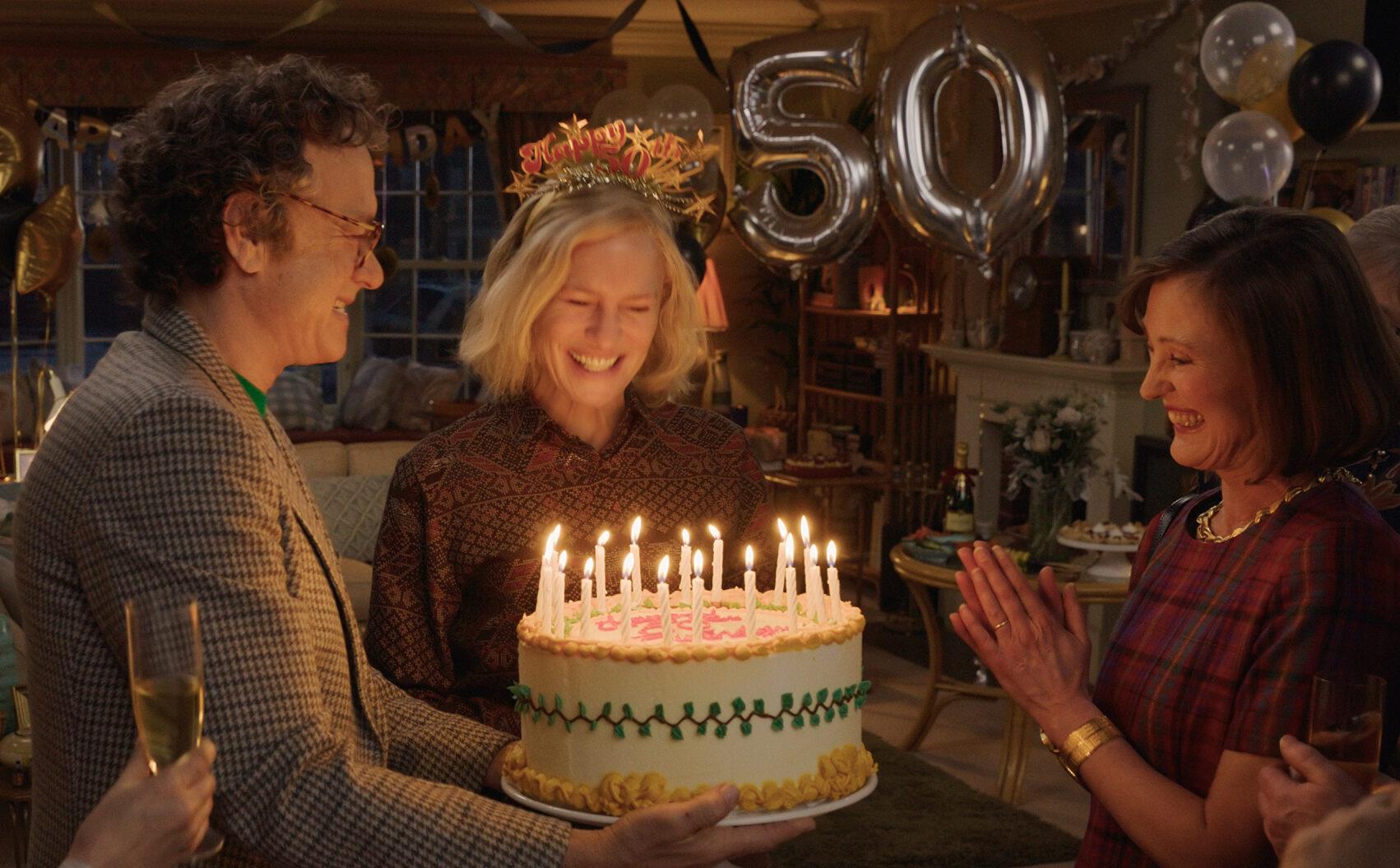VERDICT: Robert Zemeckis’ fixed-camera observation of the passage of time is a slick and profoundly shallow movie aching for depth.
Nothing less than the inexorable march of history, that’s the subject of Here. And yet, when Margaret (Robin Wright) teases her husband Richard (Tom Hanks) for uttering bromides like “Time flies,” as events and decades unfurl before their eyes, the film they live in refuses to contemplate that subject any more than, “Wow, it sure does.”
Director Robert Zemeckis has exactly one original idea for this ostensible heart-warmer about the significance of the quotidian, and that’s to tell the entire story from a single fixed-camera angle; epochs jump backward and forward, but the point of view never budges. It’s an effect that gives viewers the feeling of being an audience member at a play or, more appropriately, at Disneyland’s old Carousel of Progress attraction, where a rotating stage showed tourists the same living room over decades as fashions and technology evolved at each stop.
Here doesn’t limit itself to its living room set entirely; dinosaurs roam the Earth, followed by an Ice Age, and then the forest primeval. We get a glimpse at the indigenous population and a manor house owned by Benjamin Franklin’s Royalist son. Later, a house gets built across the street, and its residents include a 1910s aviator (Gwilym Lee) and a 1930s furniture inventor (David Fynn) and their wives (Michelle Dockery and Ophelia Lovibond, respectively), as well as a 2020s family (led by Nikki Amuka-Bird and Nicholas Pinnock).
But since this movie is a Forrest Gump reunion of Zemeckis, co-writer Eric Roth, and lead actors Hanks and Wright, every other period of history exists only as the prologue to or afterthought of the most essential epoch that ever existed, the Baby Boom era. Most of the story revolves around WWII veteran Al (Paul Bettany) and his wife Rose (Kelly Reilly) as well as their son Richard and his eventual marriage to high-school sweetheart Margaret, with all four characters dealing with crushed dreams and a seeming inability to ever move out of this house.
People are born and die, they experience triumph and disappointment, passion and rancor, and the most that Here has to say about any of this is, well, “Time flies.” And as the movie makes these facile observations, it borrows from other films that have already traveled this particular road, from the dinosaurs of The Tree of Life to the life-of-a-house from A Ghost Story. (Even the scene where Pinnock’s character instructs his son on how to survive a police stop as a young Black man is right out of The Hate U Give.)
When the Beatles’ first appearance on The Ed Sullivan Show inevitably pops up on Al’s TV set, it’s a reminder that Zemeckis kicked off his career with I Wanna Hold Your Hand and that he did, at one point, make movies about human beings and not waxwork figures. The aging and de-aging of Hanks and Wright and the other protagonists doesn’t quite plunge into the freakish uncanny valley of the director’s adaptation of The Polar Express, but it’s still off-putting, a coldly distancing maneuver at odds with the film’s appeal to human warmth.
For all the ways that Zemeckis has successfully used visual effects to advance both his stories and the craft of cinema in general — Who Framed Roger Rabbit?, Death Becomes Her, Back to the Future and its sequels — he more often than not loses himself in digital trickery at the expense of plot, character, and performance. Here definitely falls into the category of his films that feel more like science projects than cinema.
The cast gets very little to play, but they do so as industriously as possible, uttering Roth and Zemeckis’ tinny dialogue about bourgeois frustration as though Arthur Miller had written it, and the costume and production-design departments hit their marks at capturing the dress and décor of the passing eras.
Editor Jesse Goldsmith (Zemeckis’ Pinocchio) earns praise for subtly shifting the film’s action from era to era by placing frames within the frame — a rectangle around a person, or a piece of furniture — and cutting inside that inner frame before the entire field of vision jumps to a different decade. It’s a technique that keeps the time-hopping from feeling jarring (and makes the occasional intentionally jarring smash cuts all the more effective).
There’s a world where Zemeckis’ film makes for an effective 15-minute short, or where a genuine cinematic visionary interested in formal innovation takes this locked-down perspective and turns it into something special, but as it is, Here stays stuck on itself.













